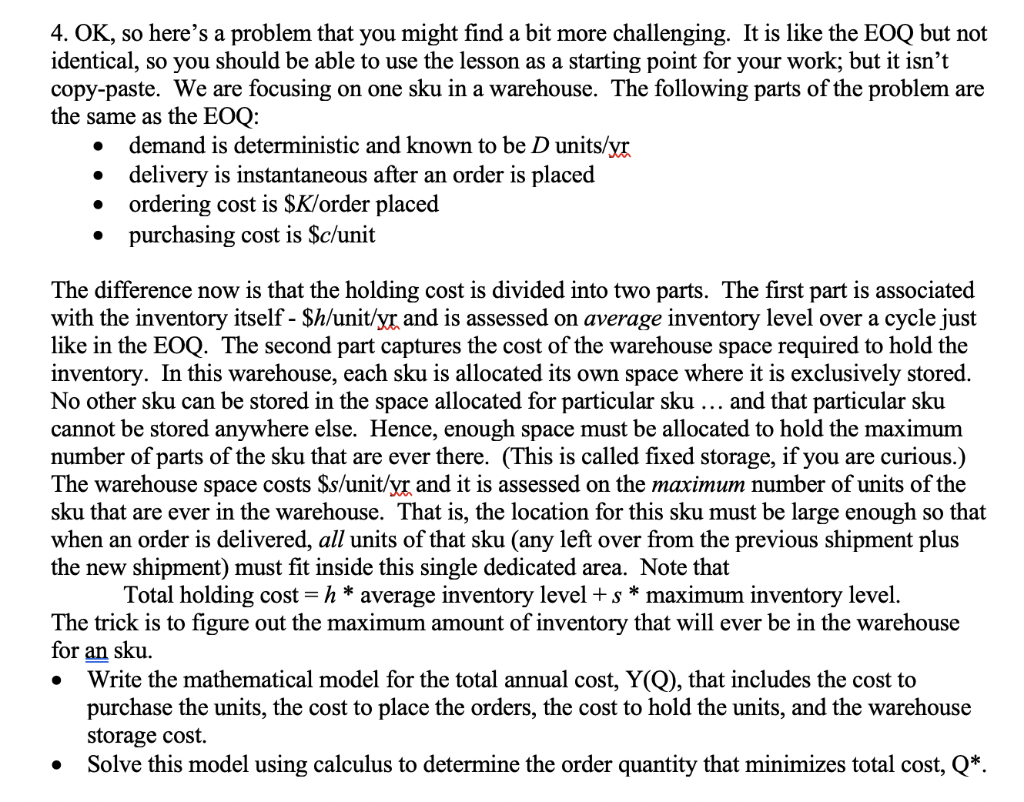
4. OK, so here's a problem that you might find a bit more challenging. It is like the EOQ but not identical, so you should be able to use the lesson as a starting point for your work; but it isn't copy-paste. We are focusing on one sku in a warehouse. The following parts of the problem are the same as the EOQ: demand is deterministic and known to be D units/yr delivery is instantaneous after an order is placed ordering cost is $K/order placed purchasing cost is $c/unit 0 . The difference now is that the holding cost is divided into two parts. The first part is associated with the inventory itself - $h/unit/yr and is assessed on average inventory level over a cycle just like in the EOQ. The second part captures the cost of the warehouse space required to hold the inventory. In this warehouse, each sku is allocated its own space where it is exclusively stored. No other sku can be stored in the space allocated for particular sku ... and that particular sku cannot be stored anywhere else. Hence, enough space must be allocated to hold the maximum number of parts of the sku that are ever there. (This is called fixed storage, if you are curious.) The warehouse space costs $s/unit/yr and it is assessed on the maximum number of units of the sku that are ever in the warehouse. That is, the location for this sku must be large enough so that when an order is delivered, all units of that sku (any left over from the previous shipment plus the new shipment) must fit inside this single dedicated area. Note that Total holding cost = h * average inventory level +s* maximum inventory level. The trick is to figure out the maximum amount of inventory that will ever be in the warehouse for an sku. Write the mathematical model for the total annual cost, Y(Q), that includes the cost to purchase the units, the cost to place the orders, the cost to hold the units, and the warehouse storage cost. Solve this model using calculus to determine the order quantity that minimizes total cost, Q*. . 4. OK, so here's a problem that you might find a bit more challenging. It is like the EOQ but not identical, so you should be able to use the lesson as a starting point for your work; but it isn't copy-paste. We are focusing on one sku in a warehouse. The following parts of the problem are the same as the EOQ: demand is deterministic and known to be D units/yr delivery is instantaneous after an order is placed ordering cost is $K/order placed purchasing cost is $c/unit 0 . The difference now is that the holding cost is divided into two parts. The first part is associated with the inventory itself - $h/unit/yr and is assessed on average inventory level over a cycle just like in the EOQ. The second part captures the cost of the warehouse space required to hold the inventory. In this warehouse, each sku is allocated its own space where it is exclusively stored. No other sku can be stored in the space allocated for particular sku ... and that particular sku cannot be stored anywhere else. Hence, enough space must be allocated to hold the maximum number of parts of the sku that are ever there. (This is called fixed storage, if you are curious.) The warehouse space costs $s/unit/yr and it is assessed on the maximum number of units of the sku that are ever in the warehouse. That is, the location for this sku must be large enough so that when an order is delivered, all units of that sku (any left over from the previous shipment plus the new shipment) must fit inside this single dedicated area. Note that Total holding cost = h * average inventory level +s* maximum inventory level. The trick is to figure out the maximum amount of inventory that will ever be in the warehouse for an sku. Write the mathematical model for the total annual cost, Y(Q), that includes the cost to purchase the units, the cost to place the orders, the cost to hold the units, and the warehouse storage cost. Solve this model using calculus to determine the order quantity that minimizes total cost, Q*







